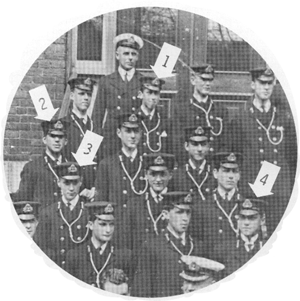![[Canadian Naval Jack]](cdnjack.jpg)
![[Canadian Naval Jack]](cdnjack.jpg)
It is not commonly known that the first casualties in the Royal Canadian Navy were four midshipmen, doing their "big ship time" in the armoured cruiser HMS Good Hope. They perished along with the rest of their shipmates at the Battle of Coronel, 1 November 1914.

(from Crowsnest, November 1964)
They were:
Marc Milner has recently pointed out (in Canada's Navy: the First Century, page 43) that Rear-Admiral Craddock specifically requested that Silver and Palmer join Good Hope and that the other two were drawn by lot.
Three can be seen in the following photograph:
Officers Aboard HMS Good Hope, Falkland Islands, 18 October 1914
Back row, Left - Right
Surgeon de Verteuil, MD (see below); Ass. PayM. S. W. Watson; Lt. J. Fisher; Cdr. A. T. Darley;
Capt. Partridge, RMLI; PayM. J. E. Tizard; Cdr.(N) W. Scott; LCdr. G. B. Gaskell;
S-Lt. J. A. Cotter.
Middle row, L-R
PayM. J. Egremont; (behind) Lt. G. E. E. Gray and (unknown); Lt. H. S. Walker, RMLI;
Lt.(T) L. A. Montgomery; Surgeon F. C. Searle; Flt. PayM. A. H. Veitch; Lt. A. G. Smith.
Front row, L-R
Mid. G. Trounson, RNR; Mid. M. Dowding, RNR; Mid. A. W. Silver, RCN; Mid. M. Cann, RCN; Lt. E. J. French, RNR; Clerk E. C. Webber; Mid. W. A. Palmer, RCN; Mid. K. D. Cuthbert, RNR.
HMS Good Hope, Halifax, 15 August 1914
The big smudge on the forcastle is damage to the original photo, not the ship.
This was the occasion on which seven Canadian midshipmen went aboard Good Hope's consort, HMS Suffolk. When the admiral transferred his flag to the bigger ship, he took four of the Canadian midshipmen with him. They were still in Good Hope when she met her end off Coronel on 1 November 1914.
The above two photographs and accompanying captions are courtesy of J. D. Perkins.
Radium and the Retired Naval Surgeon
by Dr. Stewart Jackson (sandjjackson@home.com), (c) 2001
On August 31st 1911, Dr Fernand L de Verteuil, MD(Edin), MRCS(Eng), LRCP(Lond), Surg RN(ret), read a paper entitled "Radium in the Treatment of Disease" to the Annual Meeting of the BC Medical Association in Vancouver. In it, he describes his own use of radium in Vancouver and describes some of the patients treated. He reported, "I shall briefly refer to one. Male, Age 65, Rodent Ulcer of left side of nose of several years duration, had eaten away lower part of nose exposing nasal cavity. The patient was completely cured after five applications of radium varying from 1 to 3 hours".
In describing the effects of radium on rodent ulcer he said, "it acts like a charm, for which condition it may be practically classified as a dead certain cure. The scar left is almost invisible, being far superior to any scar I have yet seen. In rodent ulcer it might be said that radium fulfils all the necessary conditions of an ideal prescription; it cures with certainty, safely, rapidly and pleasantly".
Dr de Verteuil went on to describe treatment in 1910 of an extensive "epithelioma" of the face, but regretted that he did not have enough radium to treat more serious conditions. He describes having two apparatuses, one containing 80 mg of radium bromide and the other 20 mg. The radium bromide was mixed with inert barium salt in a proportion of one to four and distributed at the rate of 1mg per sq cm dissolved in a special varnish spread out in a small metal receptacle. The length of application "varies from 10 minutes to 48 hours depending on the use of suitable screens of lead or platinum".
De Verteuil concluded with comments of Sir Frederick Treves from two years previously, "Radium is a new remedy, and one must exercise the greatest caution in speaking of the potentialities of a new remedy. A new remedy is a thing of great expectations and very ready promises, but sooner or later it must be associated with a measure of disappointment".
Dr de Verteuil, a retired Naval Surgeon, returned to sea at the outset of the Great War but was drowned in the sinking of HMS Good Hope at the Battle of Coronel off the coast of Chile on November 1st 1914.
Return to WWI The Maritime War
Return to WWI Archive main page.